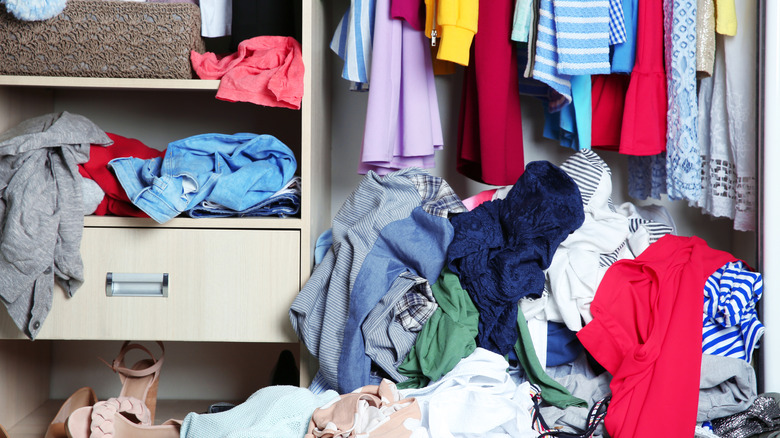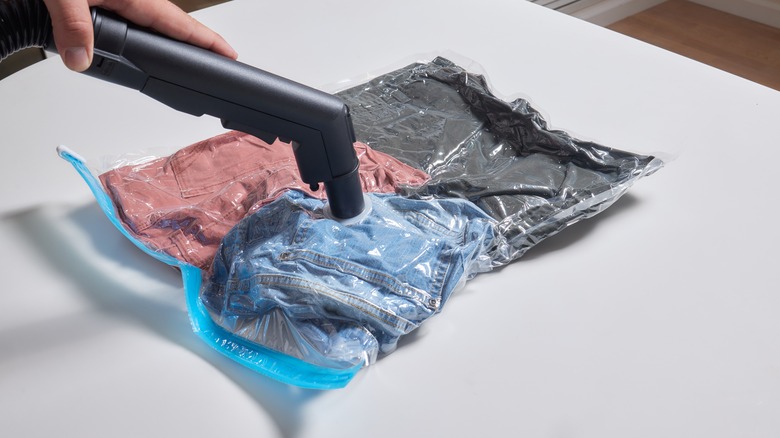This Is The Space-Saving Storage Item You Need For Your Closet
No matter how much closet space you have, it can feel like you never have enough. And that could be due to the sheer bulk of everything. It's difficult to store things like winter sweaters, coats, duvets, and blankets without them taking over a huge chunk of space. The same goes if you swap out your clothing seasonally. You need a lot fewer bins and boxes when you're folding up shorts and tees from the summer than when you're packing away knits and thick pants from the winter season. But it's not like you can carve out more usable space in your closet, right? Well, you might be wrong. You will have more room to pack these items away if you can store them in a more compressed manner. And you can easily do so with the help of vacuum storage bags.
These are plastic bags with seal tops that allow you to either squeeze or vacuum the air out of them once you fill them. By removing the air, your clothes or bedding deflates in size, allowing you to pack more onto shelves or inside storage boxes. This genius closet hack really is just that simple. However, not all bags are created equally, and you need different kinds for different items. Here is a deeper dive into how to use vacuum seal bags to free up closet space.
How to use vacuum seal bags in your closet
When it comes to storing your clothes and linens in vacuum seal bags, you first need to decide what kind to get. The cheapest option is a roll-up storage bag, which you roll to manually remove the air before sealing it. While this works well, it doesn't remove as much air as the vacuum-seal version due to the lack of suction. They also tend only to come in smaller sizes. Standard vacuum storage bags have a valve on the plastic bag, which is usually sealed closed with a rubber flap and a plastic screw cap. You usually remove the plastic screw cap and put your vacuum hose over the valve, which immediately lifts the rubber flap and begins to remove all the air from the bag. Once you turn off the hose, the rubber flap falls into place — temporarily closing the valve — and you seal it shut with the plastic cap. This is usually the better option if you want to store very bulky items, such as sweaters, duvets, and puffer coats.
The size of the bag also matters. Different brands offer different measurements, but you can usually choose between small, medium, large, and jumbo-sized bags. Small bags are great for miscellaneous items, such as bathing suits or beanies. However, jumbo bags are best utilized for large items, such as blankets, bedding sets, and hoodie collections. Choosing the right size curbs you from overstuffing the bags, which ensures a longer-lasting seal.
Caveats to keep in mind
Now that you know your bag options, you should know some potential pitfalls and caveats. Vacuum seal bags usually come with max fill lines, which show you how far you can stuff the bag. Going over that fill line can potentially weaken the seal over time since there are too many garments in the bag, making it more challenging to stay closed properly. However, you shouldn't store your items in these bags indefinitely. Storage bag companies recommend keeping items inside for no longer than six months. After that, you risk creasing or mishaping the stored items.
It's also not recommended to store certain items inside. For example, pieces made from natural materials such as wool, leather, fur, or silk can become permanently misshapen or wrinkled. Bulkier items like stuffed animals can also become distorted, so it's best to store them in bins or boxes. If you live in a very humid area, you can also risk developing mold or mildew in the bags if they're not stored in a cool, dry place. That's because the bags remove all air — which means that it eliminates all ventilation — so moisture can easily condense inside. Keep these things in mind before tossing your pieces into these storage bags.

